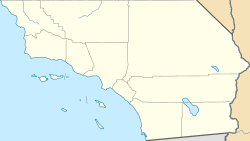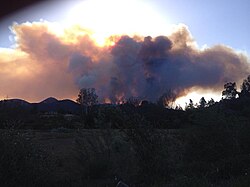| Cocos Fire | |
|---|---|
| Part of the May 2014 San Diego County wildfires | |
 The Cocos Fire burning above CSU San Marcos, on May 14, 2014 | |
| Date(s) |
|
| Location | San Marcos, San Diego County, California |
| Coordinates | 33°06′49″N117°09′36″W / 33.1137°N 117.1599°W |
| Statistics [1] | |
| Burned area | 1,995 acres (8 km2) |
| Impacts | |
| Deaths | None reported |
| Non-fatal injuries | 3 |
| Structures destroyed | 40 |
| Damage | $5.7 million (2014 USD) [2] |
| Ignition | |
| Cause | Arson |
| Perpetrator(s) | Unidentified juvenile |
| Map | |
Cocos Fire, originally known as the Twin Oaks Fire, [3] was a wildfire that ignited on May 14, 2014 in San Marcos, California, in the hills south of California State University, San Marcos. [4] The Cocos Fire quickly spread into western Escondido. The fire destroyed more than 40 buildings, including a dozen single-family homes. [5] The Harmony Grove Spiritualist Association, a 13-acre spiritualist retreat founded in 1896, was particularly hard hit; [6] most of the buildings and residences on the property were destroyed, and the association's president said, "We're pretty much wiped out." [7] Property damage from the fire is estimated at more than $5.7 million. Three minor injuries have been reported. [2] The Cocos Fire was the last of the May 2014 wildfires in San Diego County to be extinguished, with full containment on May 22, 2014. [1]



